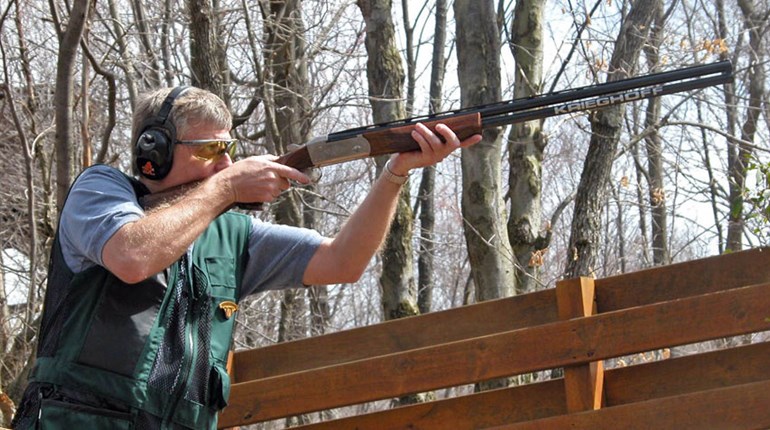
If you’re new to guns and shooting, know this: Accuracy doesn’t just “happen.” Once you begin the process, it does not take long to realize that firing a handgun accurately can be more difficult to accomplish than using a rifle for the first time. With the handgun, the first procedure you must become proficient with is the hold. This can vary as to the type of action, the grips—and especially the handgun’s construction. Here are some suggestions, starting with the easiest type of handgun to master.
Thompson/Center Arms Single Shots
In my experience T/C single shots, such as the Contender or newer Encore, handle about the same. Their grips which work well, with my preference being for those fashioned from rubber or similar material, especially with finger grooves. For me, rubber grips feel the best and when in the hand, they stay put even during heavy recoil and there is nothing sharp or hard (such as checkering) cutting into my hand.
SA or Single-Action Revolvers
The grips on this type of handgun are usually smooth and in some ways, they remind me of a handle on an old-fashioned hand plow with its slight curve. To fire, the hammer must first be retracted, which also rotates the cylinder. Once the hammer is all the way back (or “cocked”), when the trigger is squeezed, the hammer is released to strike the primer. This procedure is necessary for each shot! With this design, on firing a .357 Magnum and larger, the barrel rises and the action/smooth grips move downward in the hand, which takes some of the bite out of the recoil. Due to being designed to move in the hand, rubber grips are not recommended. On a .22 LR, you could even use target grips with the thumb rest since there is no recoil…but be careful with other calibers. A “target shooting” friend of mine many years ago had custom wooden target grips made for his SA Ruger .44 Magnum. I aimed it and it was quite steady. Then when I fired, wow, it was brutal! I asked why this type of grip and he said that they are the steadiest for him and he will only use this revolver for targets and only shoot light .44 Specials. Today, I also experiment with grips and had a Mag-na-Brake put on my 10-inch barreled .454 Casull which drastically cut down on muzzle lift. This handgun was now such a pleasure to fire that I put on Pachmayr rubber grips and it actually worked out well, and is still quite comfortable to shoot.
DA or Double-Action Revolvers
This type of revolver can be fired using the same procedure as with the SA. However, the real attraction is in the double-action mode. When the trigger is squeezed, the hammer is raised or cocked while rotating the cylinder. Then once fully cocked, the hammer is released to fire the handgun. However, for safety reasons, this is a long, heavy trigger pull. That can result in reduced accuracy, especially for newbies.
Then there are DA-only revolvers which do not have available the SA use mode option. Obviously, these are not designed for hunting (although, of course, it’s certainly possible to do). On a DA handgun for hunting, the cocking option is preferred since, as with the single action, less pressure is required on the trigger to fire. Generally, this means less gun movement, which helps with an accurate shot. Also, with DAs, reloading is much faster that unloading and loading a SA. On DA revolvers, especially if double action, ported or not, I prefer a rubber grip which for me helps to keep the revolver at the same position in my hand—greatly improving my time for an accurate second shot.

Pictured: Slide bite, just waiting to happen.
Semi-Autos
Anyone who fires handguns will look at the photo and wince! With the thumb up when firing a semi, that is an accident waiting to happen and will occur once the trigger is squeezed. This is a common injury on the range with novices or even experienced shooters who have slipped up while trying rapid fire. This is why I always stress to new shooters to get in the habit of using one hold for everything. If you’re a right-handed shooter, put your left hand along the left of the handguns grip (back from the cylinder gap) for support. Then do the same with all other handguns no matter the action type. It is so important to develop a procedure when aiming that is the same for all types of handguns and with that, a thumb up and then sliced by the slide as shown in the photo will not happen. (Editor’s note: For more information on avoiding a “slide bite,” click here!)
Hint: Reducing Recoil
A grip that fits you as well on a single shot or DA revolver helps to reduce the bite of recoil. On a SA, the smooth grip is preferred if the barrel has not been ported, as with the very effective Mag-na-Brake. Yet on a .460 and .500 S&W DA revolver, whose barrels have arrestors from the factory and are also Mag-na-Ported, along with the excellent factory rubber grips, I found that the recoil is quite tolerable for most anyone. Then with experience and once you become used to more recoil than a .357 Magnum, which you now see as tolerable and controllable, the recoil does not interfere with accurate shooting.






































